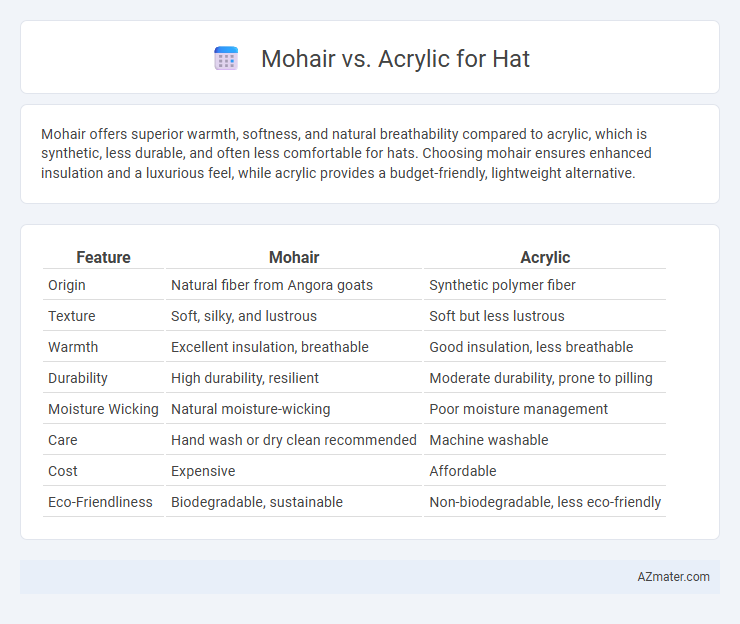Mohair offers superior warmth, softness, and natural breathability compared to acrylic, which is synthetic, less durable, and often less comfortable for hats. Choosing mohair ensures enhanced insulation and a luxurious feel, while acrylic provides a budget-friendly, lightweight alternative.
Table of Comparison
| Feature | Mohair | Acrylic |
|---|---|---|
| Origin | Natural fiber from Angora goats | Synthetic polymer fiber |
| Texture | Soft, silky, and lustrous | Soft but less lustrous |
| Warmth | Excellent insulation, breathable | Good insulation, less breathable |
| Durability | High durability, resilient | Moderate durability, prone to pilling |
| Moisture Wicking | Natural moisture-wicking | Poor moisture management |
| Care | Hand wash or dry clean recommended | Machine washable |
| Cost | Expensive | Affordable |
| Eco-Friendliness | Biodegradable, sustainable | Non-biodegradable, less eco-friendly |
Introduction to Mohair and Acrylic
Mohair, derived from the Angora goat, is a luxurious natural fiber known for its softness, sheen, and excellent insulation properties, making it a premium choice for high-quality hats. Acrylic, a synthetic fiber, offers durability, affordability, and easy maintenance, often mimicking the appearance and warmth of natural fibers while being wrinkle-resistant and hypoallergenic. Understanding the distinct qualities of mohair and acrylic aids in selecting the ideal material for comfort, style, and practicality in headwear.
Understanding Mohair: Origins and Properties
Mohair, derived from the Angora goat, is renowned for its silky texture, natural sheen, and exceptional warmth, making it a premium choice for hat material. Its fibers are long, smooth, and strong, offering durability and a lightweight feel that contrasts sharply with synthetic options like acrylic. The natural insulating properties and moisture-wicking ability of mohair ensure comfort and breathability, distinguishing it from the less breathable acrylic fibers commonly used in affordable hat production.
Overview of Acrylic Fibers
Acrylic fibers are synthetic polymers primarily derived from polyacrylonitrile, valued for their lightweight, soft texture, and resistance to moisture and mildew. These fibers offer excellent color retention and durability, making them a popular choice for hats that require frequent washing and long-lasting vibrancy. Acrylic hats provide a budget-friendly alternative to natural fibers like mohair, with easy care and hypoallergenic properties.
Comfort and Softness Comparison
Mohair offers superior softness and a luxurious, smooth texture that remains lightweight and breathable, making hats comfortable for extended wear. Acrylic fibers, while more affordable and often machine washable, tend to be less soft and can sometimes feel coarse or synthetic against the skin. Comparing comfort, mohair hats provide better moisture-wicking and temperature regulation, resulting in enhanced softness and overall comfort compared to acrylic alternatives.
Warmth and Insulation Abilities
Mohair offers superior warmth and insulation for hats due to its natural hollow fibers, which trap heat effectively and provide excellent breathability. Acrylic, a synthetic material, provides decent insulation but lacks the moisture-wicking and temperature-regulating properties of mohair. Hats made from mohair are ideal for cold climates, offering lightweight warmth without overheating.
Durability and Longevity
Mohair fibers, derived from the Angora goat, offer exceptional durability due to their natural strength and resilience, maintaining softness and shape over prolonged use. Acrylic hats, while affordable and resistant to moths and mildew, tend to wear out faster, often pilling and losing elasticity with regular wear. For long-lasting headwear, mohair provides superior longevity and retains insulation properties better than synthetic acrylic.
Breathability and Moisture Control
Mohair hats excel in breathability due to their natural fibers, allowing air circulation that prevents overheating and enhances comfort in varying temperatures. Acrylic hats, composed of synthetic fibers, tend to retain moisture and heat, resulting in less effective breathability and potential discomfort from sweat accumulation. The superior moisture-wicking properties of mohair make it an ideal choice for hats designed to maintain dryness and regulate scalp temperature efficiently.
Care and Maintenance Differences
Mohair hats require gentle hand washing with cold water and mild detergent to preserve their softness and prevent fiber damage, while acrylic hats are machine washable and more resistant to shrinking or stretching. Mohair fibers are sensitive to heat and agitation, necessitating careful drying flat away from direct sunlight, whereas acrylic hats dry quickly and maintain shape with minimal effort. These care differences make acrylic hats more practical for daily use, but mohair offers superior durability and a luxurious feel when properly maintained.
Cost and Accessibility
Mohair hats typically cost more due to the natural fiber's rarity and complex harvesting process, making them a premium choice for quality and warmth. Acrylic hats offer a budget-friendly alternative, widely available in various colors and styles, making them highly accessible for everyday use. Consumers seeking affordability and ease of maintenance often prefer acrylic, while those valuing luxury and durability invest in mohair.
Eco-Friendliness and Ethical Considerations
Mohair, derived from the Angora goat, offers a biodegradable and renewable fiber that supports sustainable farming practices when sourced responsibly, reducing environmental impact compared to synthetic options. Acrylic, a petroleum-based synthetic fiber, requires significant fossil fuel resources and poses challenges in biodegradability, contributing to microplastic pollution and longer-term environmental harm. Ethically, mohair production is scrutinized for animal welfare concerns, emphasizing the importance of cruelty-free certification, whereas acrylic avoids animal use but raises issues related to fossil fuel extraction and chemical processing.

Infographic: Mohair vs Acrylic for Hat
 azmater.com
azmater.com